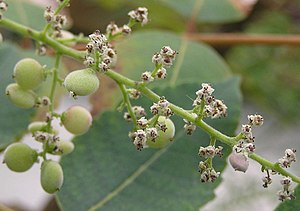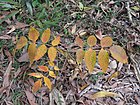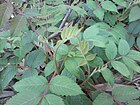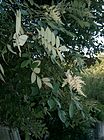Note: This is a project under development. The articles on this wiki are just being initiated and broadly incomplete. You can Help creating new pages.
Rhus chinensis
Rhus chinensis is a deciduous shrub or small tree with an open, spreading crown' it usually grows from 2 - 12 metres tall. The bole can be 6 - 18cm in diameter. The plant has an extensive root system and spreads by means of suckers, often forming thickets. The tree has a range of uses including - producing an edible fruit; having medicinal properties; a source of tannins, dye plant and source of oil. It is gathered from the wild and mainly used locally. Galls produced as a result of insect activity on the plant are widely used medicinally in east Asia, especially in polyherbal preparations, and are often traded.
Contents
[hide]- 1 Uses
- 2 Parts Used
- 3 Chemical Composition
- 4 Common names
- 5 Properties
- 6 Habit
- 7 Identification
- 8 List of Ayurvedic medicine in which the herb is used
- 9 Where to get the saplings
- 10 Mode of Propagation
- 11 How to plant/cultivate
- 12 Commonly seen growing in areas
- 13 Photo Gallery
- 14 References
- 15 External Links
Uses
Diarrhoea, Haemorrhage, Persistent cough, Spontaneous sweating, Night sweats, Bloody stool, Urorrhoea, Bloody sputum, Haemoptysis, Inflammations, Laryngitis.[1]
Parts Used
Chemical Composition
Ten compounds were obtained: β-sitosterol (1), morolic acid (2), (2S) -1-O-heptatriacontanoyl glycerol (3), α-monpalmitin (4), palmitic acid (5), gallic acid (6), methyl gallate (7), ethyl gallate (8), propyl gallate (9), and protocatechuic acid (10)[2]
Common names
| Language | Common name |
|---|---|
| Kannada | |
| Hindi | Tatri |
| Malayalam | |
| Tamil | |
| Telugu | |
| Marathi | |
| Gujarathi | |
| Punjabi | |
| Kashmiri | |
| Sanskrit | |
| English | Chinese Sumac |
Properties
Reference: Dravya - Substance, Rasa - Taste, Guna - Qualities, Veerya - Potency, Vipaka - Post-digesion effect, Karma - Pharmacological activity, Prabhava - Therepeutics.
Dravya
Rasa
Guna
Veerya
Vipaka
Karma
Prabhava
Habit
Identification
Leaf
| Kind | Shape | Feature |
|---|---|---|
Flower
| Type | Size | Color and composition | Stamen | More information |
|---|---|---|---|---|
| {{{5}}} |
Fruit
| Type | Size | Mass | Appearance | Seeds | More information |
|---|---|---|---|---|---|
Other features
List of Ayurvedic medicine in which the herb is used
Where to get the saplings
Mode of Propagation
Seeds, Cuttings of half-ripe wood, Root cuttings, Suckers.
How to plant/cultivate
Rhus chinensis is a plant of the warm temperate to tropical zones, found at elevations of 900 metres or more in Indonesia. It only has moderate cold-hardiness, tolerating short periods with temperatures down to around -8°c when it is fully dormant.[4]
Commonly seen growing in areas
Mountain forests, Forests along streams, Thickets, Secondary forest.
Photo Gallery
References
External Links
- Ayurvedic Herbs known to be helpful to treat Diarrhoea
- Ayurvedic Herbs known to be helpful to treat Haemorrhage
- Ayurvedic Herbs known to be helpful to treat Persistent cough
- Ayurvedic Herbs known to be helpful to treat Spontaneous sweating
- Ayurvedic Herbs known to be helpful to treat Night sweats
- Ayurvedic Herbs known to be helpful to treat Bloody stool
- Ayurvedic Herbs known to be helpful to treat Urorrhoea
- Ayurvedic Herbs known to be helpful to treat Bloody sputum
- Ayurvedic Herbs known to be helpful to treat Haemoptysis
- Ayurvedic Herbs known to be helpful to treat Inflammations
- Ayurvedic Herbs known to be helpful to treat Laryngitis
- Herbs with Fruits used in medicine
- Herbs with common name in Hindi
- Herbs with common name in English
- Habit - Deciduous tree
- Index of Plants which can be propagated by Seeds
- Index of Plants which can be propagated by Cuttings of half-ripe wood
- Index of Plants which can be propagated by Root cuttings
- Index of Plants which can be propagated by Suckers
- Herbs that are commonly seen in the region of Mountain forests
- Herbs that are commonly seen in the region of Forests along streams
- Herbs that are commonly seen in the region of Thickets
- Herbs that are commonly seen in the region of Secondary forest
- Herbs






